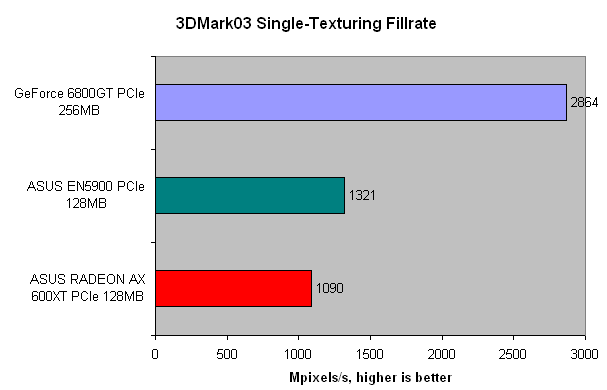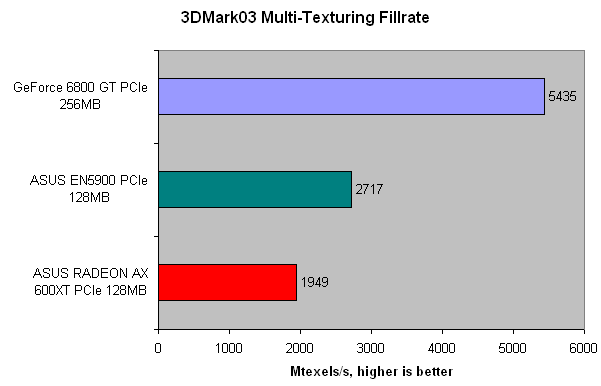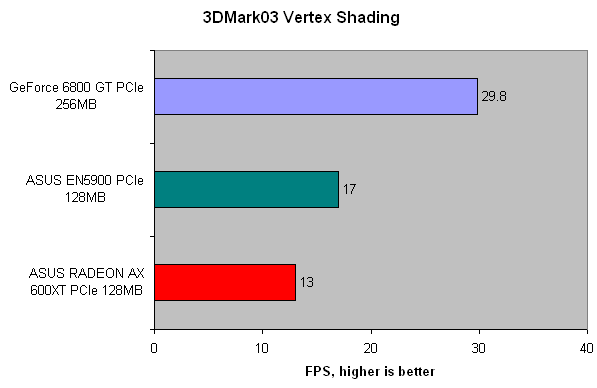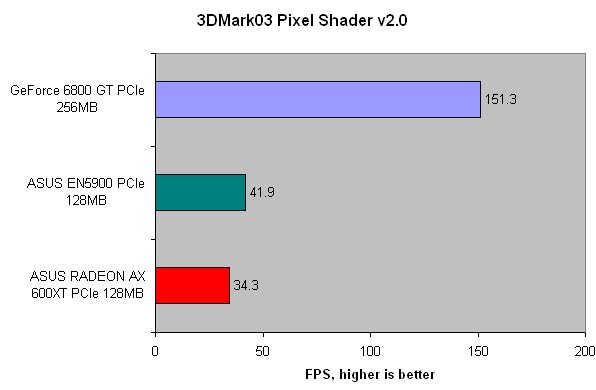Fillrate/shading power
Both cards differ in rendering and bandwidth. Let's take a closer look. I've also added in a GeForce 6800 GT 256MB PCI-Express card. It will show where both midrange cards stand in relation to a high-end performer.| Card | ASUS EN5900 PCIe | ASUS AX600XT/HTVD PCIe | GeForce 6800 GT |
| Interface | PCI-Express (X16) | PCI-Express (X16) | PCI-Express (X16) |
| Render setup | 4x1 | 4x1 | 16x1 |
| Onboard memory | 128MB | 128MB | 256MB |
| Core speed | 375MHz | 500MHz | 350MHz |
| Single-texture fillrate | 1500MPixel/s | 2000MPixel/s | 5600MPixel/s |
| Texture units | 2 | 1 | 1 |
| Multi-texture fillrate | 3000MTexels/s | 2000MTexels/s | 5600MTexels/s |
| Memory speed | 700MHz | 740MHz | 1000MHz |
| Memory bus width | 256-bit | 128-bit | 256-bit |
| Memory bandwidth | 22.4GB/s | 11.8GB/s | 32GB/s |
| Estimated price | £165 | £130 | £275 |
For the most part, GeForce 5900 XTs run with a 4x1 render setup, so in most conditions where a single texture is applied to a pixel, the EN5900's fillrate will be lower than the 500MHz-clocked AX600XT. Multi-texturing fillrate should be far better on the EN5900, thanks to two texture units. The same applies for memory bandwidth. A 256-bit memory bus provides almost double the AX600XT's theoretical peak performance. There are many factors that will impinge on potential performance. AntiAliasing/Anisotropic Filtering implementation is one. Bandwidth-saving techniques another.
I ran 3DMark03 determine how the specs related to real-world usage.

It's surprising to see the X600 XT-based card fall behind in a single-texture scenario. It's barely managing half of its theoretical 2GPixel/s fillrate, according to 3DMark03's results at 1024x768.

Multi-texturing results are better on the AX600XT but still some way behind the N5900's. It's important to note that the PCX5900 is directly derived from a GPU that was always intended to run with a 256-bit-wide memory bus. The Radeon 9600 XT, however, has always been engineered as a card with a 128-bit memory interface.

Vertex shading is also better on the PCX5900.

Nothing quite like a clean sweep. Note just how far these two midrange cards are behind the amazing shading performance of a current top-level card. It would be interesting to see how a GeForce 6600 GT compares with either card.









